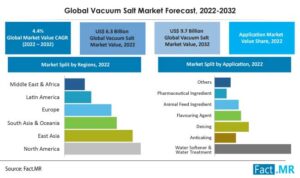Vacuum Salt Market is an essential mineral for human consumption and various industrial processes, has been a vital element in our lives for centuries. From seasoning our meals to preserving food, salt’s significance cannot be overstated. One particular segment of the salt industry that has gained prominence in recent years is the vacuum salt market. This article delves into the dynamics, trends, and factors shaping the vacuum salt market’s growth and trajectory.
Understanding Vacuum Salt:
Vacuum salt, also known as evaporated salt, is produced through the process of brine evaporation under reduced pressure. This process involves dissolving salt in water, evaporating the water under vacuum conditions, and then harvesting the salt crystals left behind. The resulting product is typically of high purity and is widely used in the food industry, chemical applications, and water treatment.
For More insights into the, Request a Sample of this Report:
Market Trends and Drivers:
Food Industry Demand: Vacuum salt market has found a strong foothold in the food industry due to its purity, fine texture, and absence of impurities commonly found in traditional rock salt. It is a preferred choice for food processing and seasoning due to its uniform particle size, solubility, and ability to enhance flavors.
Health and Wellness: As consumers increasingly seek healthier alternatives, vacuum salt is gaining traction as a perceived healthier option compared to some traditional salts. Its lower sodium content, when compared to sea salt or rock salt, appeals to health-conscious individuals.
Chemical Industry Applications: Vacuum salt is a crucial ingredient in various chemical processes, including the manufacturing of chlorine, soda ash, and other chemical compounds. These chemicals have a wide range of applications in industries such as textiles, glass, and detergents.
Water Treatment: The growth of the water treatment industry, driven by concerns about water quality and scarcity, has fueled the demand for vacuum salt. It is used in water softening processes to remove hardness-causing minerals, ensuring better water quality for industrial and domestic use.
Market Trend:
Growing Food Industry: The demand for vacuum salt is closely tied to the food industry, as it is a staple ingredient used for seasoning and food preservation. The growth of the global population and changing dietary habits were driving the demand for processed and packaged foods, which, in turn, influenced the demand for vacuum salt.
Industrial Applications: Vacuum salt is used in various industrial processes, such as chemical manufacturing, water treatment, and de-icing. Demand from these sectors can impact the overall market trend.
Health and Wellness: Consumer preferences for healthier food options were affecting the demand for healthier varieties of salt, such as iodized and low-sodium vacuum salt. Health concerns and increasing awareness of the potential adverse effects of excessive salt consumption were influencing product choices.
Sustainability and Traceability: Like many other industries, there was a growing emphasis on sustainability, traceability, and responsible sourcing in the salt industry. Consumers were showing interest in knowing the origin of the salt and the environmental impact of its production.
Regional Demand: The demand for vacuum salt varied across different regions, influenced by factors such as population growth, economic development, and cultural food preferences.
Competitive Landscape: The vacuum salt market had numerous players, ranging from large multinational corporations to regional producers. Market dynamics, including pricing strategies and innovations, were influenced by competition.
Technological Advancements: Innovations in salt production techniques and technologies could impact the industry. These innovations might involve more efficient methods of salt extraction and processing.
Challenges and Opportunities:
Competition from Alternative Salts: While vacuum salt has gained popularity, it faces competition from other specialty salts, such as Himalayan pink salt and sea salt. These alternatives are often marketed as gourmet or natural options, challenging vacuum salt’s market share.
Environmental Concerns: The production of vacuum salt requires significant energy for evaporation, which can contribute to carbon emissions. Manufacturers are exploring sustainable practices and energy-efficient technologies to mitigate these environmental impacts.
Regulatory Landscape: Stringent regulations regarding sodium consumption and labeling could impact the demand for vacuum salt in the food industry. Manufacturers may need to adapt to changing regulations and consumer preferences.
Future Outlook:
The vacuum salt market is poised for continued growth as it aligns with trends in the food industry, health-conscious consumer preferences, and expanding applications in various sectors. To stay competitive, manufacturers need to focus on product innovation, sustainability, and maintaining high quality standards. Additionally, collaboration with research institutions could lead to the development of novel applications for vacuum salt, further expanding its market potential.
